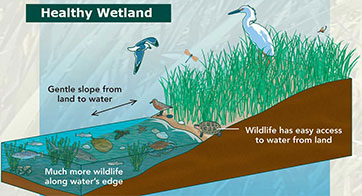Wetlands Overview
Wetlands are habitats with a unique relationship with water. Wetlands can be saturated with water, like those fringing ponds, or they can simply have moisture-laden soils. Ecologists use many terms to categorize different types of wetlands based on their wetness and what plants grow there, such as marshes, bogs, fens, or swamps.
Wetlands are important because they provide food and homes to fish, amphibians, shellfish, insects, birds and other animals. They also clean our water by filtering out pollutants and provide flood protection for our communities by acting as natural sponges.
